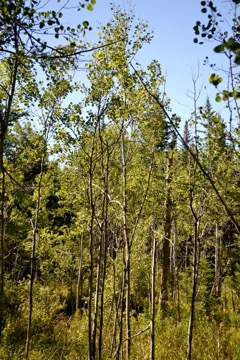
The Ever Elusive Poplar
For grouse, it is said that the leaves of a poplar are unusually nutritious, and they must be pretty tasty too, as it seems that grouse really seek out mature poplars for feeding. Stands of young poplar whips also serve as great cover for broods of grouse as well, as hens seek out the thickest cover from avian predators to raise their chicks. I've also had good luck finding woodcock in these areas as well, and I wonder if it could be because of the soil composition. As you all know, if there are no worms in an area, there won't be any woodcock either, so there must be something with stands of poplar in this regard.
Unfortunately in northern New Hampshire and Vermont, we don't have an abundance of poplar stands like they have in the midwest (out there, they're usually called "Aspen"), so it is something like finding buried treasure when you find a stand of them. For me, these places are GPS-worthy, but they often automatically find their way in to my memory bank of grouse coverts. When we're hunting these spots, those poplars will definitely be part of the plan going forward.
In the fall, the leaves of a poplar turn a golden yellow and I've found that they stay on a bit longer than some of the other hard woods, making them easy to pick out from the landscape. God take pity on clients of mine if a stand of golden leaved poplars are spotted from some high ridge across a valley! This exact occurence took place a number of years ago in mid-October. A solid but unspectacular morning with my clients Mike and Lou had me wondering what to do next … when I spotted a clump of sparkling golden coins across a valley on a ridge that didn't seem that far away. Of course, we had to climb down from the ridge we were on and cross the valley, then cross a stream, and up the other side. All turned out well when we entered this little slice of grouse habitat nirvana. It was a bit of work getting there, but we got in to a few grouse and several woodcock as well, and I briefly looked like I knew what I was doing …
While I've never personally hunted in the Midwest for grouse, there are supposedly tremendous concentrations of poplar, and perhaps that is why Minnesota, Wisconsin and Michigan are considered the epicenter of grouse hunting in North America. Here in the east, we have to be content with smaller pockets of poplars, mixed with our maple, birch, beech and assorted soft woods. Together, our combination of tree species makes a nice mosaic of habitat for our birds, and we'll just have to be content with that.
The picture above was taken this morning in Pittsburg, NH - we had the good fortune of finding two grouse and three woodcock nearby. Perhaps that proves my point!
